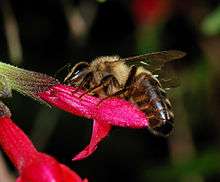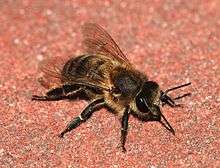European dark bee
| European dark bee | |
|---|---|
 | |
| The Savoie honeybee has rather light wings for a black bee (note ample hair on thorax and black abdomen with little hair) | |
| Scientific classification | |
| Kingdom: | Animalia |
| Phylum: | Arthropoda |
| Class: | Insecta |
| Order: | Hymenoptera |
| Family: | Apidae |
| Genus: | Apis |
| Species: | A. mellifera |
| Subspecies: | A. m. mellifera |
| Trinomial name | |
| Apis mellifera mellifera Linnaeus, 1758 | |
The European dark bee (Apis mellifera mellifera) is a subspecies of honey bee whose original European range stretched from western Russia through Northern Europe and probably down to the Iberian Peninsula. It was domesticated in Europe and hives were brought to North America in the colonial era. They are large for honey bees though they have unusually short tongues. They are sometimes called the German black bee or German dark bee.[1]
There are three main races, namely
- mellifera (brown bee)
- lehzeni (heathland bee)
- nigra (black bee),
which have local breeds, such as the Pomeranian brown, the Alps black, or the black Scandinavian. All of the subspecies belong to the 'M' lineage of Apis mellifera.[2]
The European dark bee can be distinguished from other subspecies by their stocky body, abundant thoracal and sparse abdominal hair which is brown, and overall dark coloration; in nigra, there is also heavy dark pigmentation of the wings. Overall, when viewed from a distance, they should appear blackish, or in mellifera, rich dark brown. The aggressive feral hybrids with other subspecies can be distinguished by the lighter, yellowish banding on the sides of the abdomen, but this is often difficult. For breeding pure dark bees according to the standard, details of the wing veins are nowadays considered to be the only reliable distinguishing character.
Character
Hybrids have a defensive character and have the reputation of stinging people (and other creatures) for no apparent reason. Some colonies are very "runny" on the comb and so excitable that beekeepers consider them difficult to work with. This characteristic is not, however, one that has been traditionally associated with the dark bee breeds, which were previously known for their rather easy handling (though they have never been considered as placid as the Carniolan honey bee).
Qualities
- significant winter hardiness (linked to their foraging choices in opposition to that of the African honey bee, A. m. scutellata)
- low tendency to swarm
- some lines are very gentle
- defensive against invaders such as wasps
- careful, measured "maritime" brood cycle
- strong drive to collect pollen
- high longevity of the worker bees and queen
- excellent flight strength even in cold weather
- possibly hardiness against Varroa[3]
Significance
Apis mellifera mellifera is no longer a significant commercial subspecies of the Western honey bee, but there are a number of dedicated hobbyist beekeepers that keep these bees in Europe and other parts of the world. Immigrants brought these subspecies into the Americas. Prior to their arrival, the American continent did not have any honey bees. Hybrid descendants of the original colonial black bees may also have survived in North America as feral bees. There are reports by beekeepers that, after the arrival of the Varroa mite on the American continent in 1987, some feral bee colonies survived. The original form is no longer present in North America. A common myth regarding European black bees is that they cannot sting because they do not have a stinger.

In Western Europe, dark bee breeds were the original honey bee stock until creation of the Buckfast bee. This is a hybrid breed whose progeny includes salvaged remnants of the British black bee, nearly extinct by then due to Acarapis woodi (acarine mite). The breeding stocks in Central Europe were nearly destroyed by order of the Nazis, who considered the honey yields not up to modern standards and wanted to "improve" the bee stocks kept in areas under their control.
This led to the creation of more aggressive, high-yield breeds (probably by cross-breeding dark and Buckfast high-yield strains with Carniolan honey bees), which, however, were very susceptible to Varroa mite infection and unpleasant to handle and were dropped from use after World War II, but just as in North America, some feral colonies survive. In the United States, 'M' lineage honey bees have been found in Arkansas, Louisiana, Mississippi, Oklahoma and Missouri, based on DNA sequencing analysis.[4] Dedicated breeders and research facilities are today working on preserving and spreading what could be saved from the original stocks. There are only a handful of colonies present in Germany, but larger numbers have survived in Norway (lehzeni), the Alps (nigra) and Poland and Belgium (mellifera).
References
- ↑ Mark L. Winston (1991). The Biology of the Honey Bee. Harvard University Press. p. 10. ISBN 978-0-674-07409-5.
- ↑ Ruttner, F. (1988). Biogeography and Taxonomy of Honey Bees. Berlin/Heidelberg: Springer-Verlag. ISBN 3-540-17781-7.
- ↑ "Die Dunkle Biene" [The dark bee]. Nordbiene (in German).
- ↑ "Honey Bee & Bumble Bee Genetics Research". Insects Genetics Lab. University of Arkansas. Archived from the original on 27 May 2011.
External links
| Wikimedia Commons has media related to Apis mellifera mellifera. |
| Wikispecies has information related to: Apis mellifera mellifera |
- Waugh, Rob (11 July 2012). "Good to bee back: 'Extinct' British breed of honeybee found alive and well in church rafters after nearly 80 years". Daily Mail.
- BIBBA: Bee Improvement and Bee Breeders Association (UK and Ireland)
- "Apis mellifera mellifera-Dunkle Biene" [Apis mellifera mellifera Dark Bee] (in German).
- "Mellifera.ch: Verein Schweizerischer Mellifera Bienenfreunde" [Association of Swiss Mellifera Beefriends] (in German).
- "Gemeinschaft zum Erhalt der Dunklen Biene e.V." [Society for the Conservation of the Dark Bee] (in German).